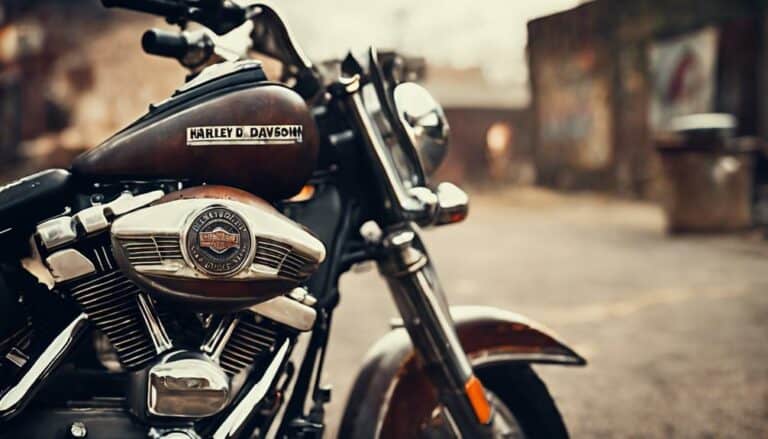If you own a Harley Davidson with a 103 engine, did you know that it's one of the most popular engine sizes among Harley enthusiasts?
However, despite its popularity, there are certain issues you should be aware of. From overheating concerns to cam chain tensioner wear, the Harley Davidson 103 motor has its fair share of challenges.
Understanding these common problems and how to address them can help you ensure the smooth operation of your beloved Harley.
Key Takeaways
- Compensator failures and sticking valves are common issues with the Harley 103 engine.
- Regular maintenance such as oil changes and component inspections can prevent engine problems.
- Upgrading with Stage 1 Kit and aftermarket parts can enhance engine performance.
- Proper care and attention can extend the longevity of the Harley 103 engine up to 200,000 miles.
Common Issues With Harley 103 Engine
Common problems plaguing the Harley Davidson 103 engine encompass compensator failures, sticking valves, worn crank bearings, cracking cylinder heads, and engine knocking. Compensator failures in the engine can lead to clunking sounds and difficulty shifting gears, acting as red flags for potential issues.
Regular maintenance plays an important role in extending the engine's lifespan, with rebuilds typically necessary around the 75,000-mile mark. Symptoms of worn crank bearings, such as excessive vibration and noise, shouldn't be ignored, as they indicate the need for immediate attention to prevent further damage.
Engine knocking, often caused by low-octane fuel or overheating, underscores the importance of proper fuel and cooling system upkeep to avoid such problems. Addressing these common issues promptly through regular maintenance can help keep your Harley Davidson 103 engine running smoothly and reliably, ensuring a liberating riding experience.
Troubleshooting Harley 103 Engine Problems
To effectively troubleshoot issues with your Harley Davidson 103 engine, meticulously inspect all components for signs of wear or malfunction. Start by checking for symptoms such as compensator failures, indicated by clunking or knocking sounds and difficulty shifting gears.
Sticking valves can cause performance issues, while worn crank bearings may lead to engine knocking. Cracked cylinder heads are another common problem that requires immediate attention. If you suspect any of these issues, a thorough examination of fuel delivery components and the cooling system is essential.
Look out for clogged injectors, leaking coolant, or fuel delivery problems that could be impacting your engine's performance. Remember, proper maintenance is key to preventing these issues, so make sure you adhere to regular servicing, cleaning, oil changes, and part replacements to keep your Harley 103 engine running smoothly and efficiently.
Maintenance Tips for Harley 103 Engine
Inspecting and maintaining key components of your Harley 103 engine at recommended mileage intervals is important for ensuring peak performance and longevity. To keep your Harley 103 engine running smoothly, follow these maintenance tips:
- Regular oil changes every 3,000 to 5,000 miles are essential for maintaining engine health.
- Checking and replacing the air filter every 10,000 to 15,000 miles helps ensure top engine performance.
- Spark plug checks and replacements every 20,000 to 25,000 miles prevent ignition issues in the Harley 103 engine.
- Valve adjustments at around 30,000 miles are recommended to maintain proper engine function and reduce wear.
- Inspecting the drive belt for wear and tension every 40,000 to 50,000 miles helps prevent belt failures in the Harley 103 engine.
Enhancing Performance of Harley 103 Engine
Enhancing the performance of your Harley 103 engine can be achieved through strategic upgrades and modifications to key components. By incorporating a stage 1 kit, aftermarket exhaust systems, Electronic Sequential Port Fuel Injection system tuning, high-flow air filter installation, and adding a performance tuner, you can notably boost the overall performance of your motorcycle.
| Upgrades | Benefits |
|---|---|
| Stage 1 Kit | Enhances performance and power output |
| Aftermarket Exhaust Systems | Improves airflow and increases horsepower |
| Electronic Sequential Port Fuel Injection System Tuning | Optimizes fuel delivery and performance |
| High-flow Air Filter | Improves air intake and boosts overall performance |
| Performance Tuner | Adjusts fuel mapping for increased power and throttle response |
These modifications work together to enhance the engine's capabilities, increase horsepower, optimize fuel delivery, and adjust fuel mapping, resulting in a notable performance improvement. Upgrade your Harley 103 engine today to experience a thrilling ride with optimized power and efficiency.
Longevity of Harley 103 Engine
The durability and performance longevity of the Harley 103 engine are influenced by various factors, including riding conditions, maintenance practices, and the quality of components utilized. Here are some key points to take into account:
- Regular service and preventive maintenance can help the Harley 103 engine last between 80,000 to 100,000 miles.
- Some riders have exceeded the 200,000-mile mark by diligently caring for their Harley 103 engine.
- The lifespan of the Harley 103 engine is heavily dependent on factors like riding conditions, maintenance routines, and the quality of parts installed.
By adhering to proper care and maintenance protocols, you can considerably extend the longevity of the Harley 103 engine, ensuring a reliable performance for hundreds of thousands of miles.
Riders have reported a significant increase in power output and an overall improved riding experience with the Harley 103 engine, showcasing its capability to enhance your journey.
Conclusion
In optimal, when it comes to the Harley Davidson 103 engine, it's important to stay on top of maintenance and address any issues promptly to optimal smooth operation.
Remember, a stitch in time saves nine, so don't ignore any warning signs or unusual noises coming from your engine.
By taking care of your Harley 103 engine, you can enjoy optimal performance and longevity for years to come.

